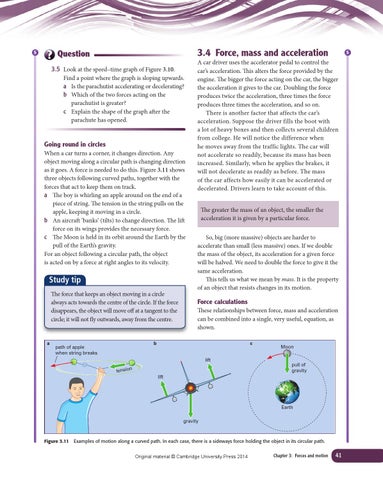S
3.4 Force, mass and acceleration
Question 3.5 Look at the speed–time graph of Figure 3.10. Find a point where the graph is sloping upwards. a Is the parachutist accelerating or decelerating? b Which of the two forces acting on the parachutist is greater? c Explain the shape of the graph after the parachute has opened.
Going round in circles When a car turns a corner, it changes direction. Any object moving along a circular path is changing direction as it goes. A force is needed to do this. Figure 3.11 shows three objects following curved paths, together with the forces that act to keep them on track. a The boy is whirling an apple around on the end of a piece of string. The tension in the string pulls on the apple, keeping it moving in a circle. b An aircraft ‘banks’ (tilts) to change direction. The lift force on its wings provides the necessary force. c The Moon is held in its orbit around the Earth by the pull of the Earth’s gravity. For an object following a circular path, the object is acted on by a force at right angles to its velocity.
Studyy tip p The force that keeps an object moving in a circle always acts towards the centre of the circle. If the force disappears, the object will move off at a tangent to the circle; it will not fly outwards, away from the centre.
a
A car driver uses the accelerator pedal to control the car’s acceleration. This alters the force provided by the engine. The bigger the force acting on the car, the bigger the acceleration it gives to the car. Doubling the force produces twice the acceleration, three times the force produces three times the acceleration, and so on. There is another factor that affects the car’s acceleration. Suppose the driver fills the boot with a lot of heavy boxes and then collects several children from college. He will notice the difference when he moves away from the traffic lights. The car will not accelerate so readily, because its mass has been increased. Similarly, when he applies the brakes, it will not decelerate as readily as before. The mass of the car affects how easily it can be accelerated or decelerated. Drivers learn to take account of this. The greater the mass of an object, the smaller the acceleration it is given by a particular force. So, big (more massive) objects are harder to accelerate than small (less massive) ones. If we double the mass of the object, its acceleration for a given force will be halved. We need to double the force to give it the same acceleration. This tells us what we mean by mass. It is the property of an object that resists changes in its motion.
Force calculations These relationships between force, mass and acceleration can be combined into a single, very useful, equation, as shown.
b
path of apple when string breaks
S
c
Moon
lift pull of gravity
tension lift
Earth gravity
Figure 3.11
Examples of motion along a curved path. In each case, there is a sideways force holding the object in its circular path. Original material © Cambridge University Press 2014
Chapter 3: Forces and motion
41
